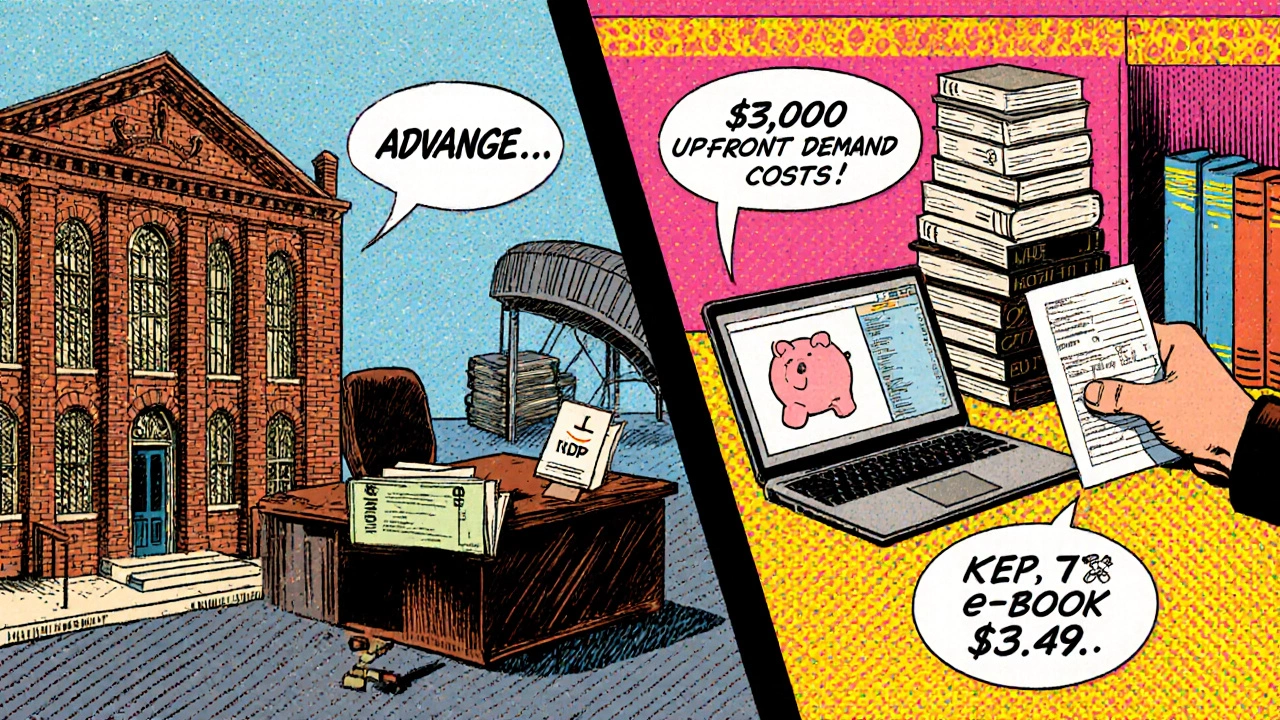
Book Earnings Calculator
Enter your details above to see your potential earnings.
Quick Takeaways
- First‑time authors typically earn an advance between $5,000 and $25,000 for a traditional deal.
- Royalty rates hover around 7‑10% of the cover price for hardcover and 5‑7% for paperback.
- Self‑publishing can produce higher per‑sale earnings, but authors cover all production costs upfront.
- Agents usually take a 15% commission of the advance and any earned royalties.
- Negotiating a fair royalty clause and a marketing budget can boost total earnings by 20‑40%.
Ever wondered what cash actually lands in a debut author’s pocket after signing a book deal? The answer isn’t a single number-it's a mix of advances, royalties, agent fees and marketing spend. This guide breaks down every money‑moving piece so you can picture a realistic earnings range, compare traditional publishing with self‑publishing, and walk away with a checklist you can use when you get that contract on the table.
First‑time author is a writer releasing their debut manuscript to the market, often without a proven sales record. For many, the first book deal sets the financial baseline for the rest of their career.
What Is a Book Deal, Anyway?
A book deal is a legally binding book contract that outlines how a publishing house will produce, distribute and sell the author's work. The contract typically covers:
- Advance payment (the upfront sum against future royalties)
- Royalty percentages and how they’re calculated
- Rights granted (print, e‑book, audio, foreign)
- Marketing budget and promotional responsibilities
- Timeline for delivery and publication
Understanding each clause is crucial because every percentage point or dollar figure directly impacts the final paycheck.
Traditional Publishing Advances
In a traditional deal, the advance is the author’s guaranteed income before any books are sold. Advances can be split into multiple payments (signing, delivery, publication) but the total amount stays the same.
Typical ranges in 2025 (U.S. and Australian markets) look like this:
- Small independent presses: $1,000-$5,000
- Mid‑size houses: $5,000-$15,000
- Major trade publishers: $10,000-$30,000 (occasionally higher for high‑concept debuts)
Factors that push an advance to the higher end include:
- Compelling market hook (e.g., a trending genre or timely subject)
- Strong platform or social‑media following
- Agent’s negotiation skill
- Pre‑sale of subsidiary rights (film, translation)
Remember, the advance is recoupable. The publisher recovers it from the author’s royalty earnings before any additional payments are made.
Royalty Rates and How They Translate to Money
Royalty rates are expressed as a percentage of the book’s list price or net receipts. In 2025 the standard rates for debut authors are:
- Hardcover: 10% of list price (or 15% of net if printed on demand)
- Paperback: 7% of list price
- E‑book: 25% of net receipts
- Audiobook: 10%‑12% of net receipts
Let’s do a quick calculation. Assume a $25 hardcover, 10% royalty, and a $12,000 advance.
- Royalty per copy = $25 × 10% = $2.50
- Copies needed to earn out the advance = $12,000 ÷ $2.50 ≈ 4,800 copies
If the book sells 6,000 copies in the first year, the author would earn an additional ($2.50 × 1,200) = $3,000 on top of the advance.

Self‑Publishing: Up‑Front Costs vs. Per‑Sale Earnings
Self‑publishing flips the cash flow. Authors pay for editing, cover design, ISBNs and marketing, but they keep a larger slice of each sale.
Typical cost breakdown for a professionally produced debut novel:
- Developmental edit: $1,500-$3,000
- Copy edit & proofread: $800-$1,500
- Cover design: $500-$1,200
- ISBN (one per format): $125 (U.S.) or $50 (AU)
- Marketing budget (ads, launch services): $1,000-$5,000
Average total upfront spend: $4,000-$10,000.
Royalty structures on platforms like Amazon KDP are:
- 35% royalty on books priced $2.99-$9.99 (based on list price)
- 70% royalty on books priced $2.99-$9.99 (if meeting delivery cost criteria)
Take a $4.99 e‑book sold at 70% royalty: author earns $3.49 per copy. To break even on a $7,000 outlay, the author needs roughly 2,010 sales. Compared to the traditional route, the break‑even point is lower, but the risk is entirely on the author.
Hybrid & Alternative Publishing Models
Hybrid publishers sit between traditional and self‑publishing. They often charge a fee (or share profits) but provide distribution and some editorial support.
Typical hybrid contracts offer:
- Advance: $0-$2,000 (rare)
- Royalty split: 40%-60% to the author
- Up‑front service fee: $2,000-$5,000
Authors who lack a platform but want professional polish sometimes find hybrids attractive, provided they scrutinize the fee‑to‑service ratio.
The Agent’s Role in Boosting Earnings
A literary agent acts as the intermediary between author and publishing house. Agents typically earn 15% of the advance and any earned royalties.
Beyond the commission, agents add value by:
- Securing higher advances through market knowledge.
- Negotiating better royalty clauses (e.g., escalators after a certain sales threshold).
- Packaging subsidiary rights deals that can add $1,000-$10,000 in extra income.
For a $15,000 advance, the author pockets $12,750 after the 15% commission. If the agent also lands a $5,000 foreign translation right, the author receives an extra $4,250 (agent’s cut already taken).
Real‑World Example: From Contract to Cash
Imagine Maya, a debut novelist in Sydney, signs a deal with a mid‑size Australian imprint. Her contract includes:
- Advance: $12,000 (paid 1/3 signing, 1/3 delivery, 1/3 publication)
- Hardcover royalty: 10% of $28 list price
- Paperback royalty: 7% of $18 list price
- Agent commission: 15%
- Marketing budget: $3,000 provided by the publisher
First‑year sales: 5,000 hardcovers and 3,000 paperbacks.
- Hardcover royalty per copy = $28 × 10% = $2.80 → 5,000 × $2.80 = $14,000
- Paperback royalty per copy = $18 × 7% = $1.26 → 3,000 × $1.26 = $3,780
- Total royalties earned = $17,780
- Advance recouped after $12,000, leaving $5,780 additional royalty
- Agent’s share = 15% of ($12,000 + $5,780) = $2,661
- Maya’s net earnings = $17,780 - $2,661 = $15,119
In this scenario, the debut author walks away with just over $15k, a decent sum for a first book, especially considering the publisher covered the marketing spend.

Checklist for First‑Time Authors Negotiating a Deal
- Know your advance range: research comparable titles in your genre.
- Ask for a clear royalty escalation clause (e.g., 12% after 5,000 copies).
- Confirm who pays for the ISBN and who owns it.
- Secure a marketing budget - ask for a minimum of $2,000 for a debut.
- Clarify subsidiary rights splits (foreign, film, audio).
- Get a copy‑editing and proof‑reading commitment in the contract.
- Understand the agent’s commission structure and any additional fees.
- Request a termination clause that protects you if the publisher fails to meet milestones.
Traditional vs. Self‑Publishing: A Side‑by‑Side Look
| Metric | Traditional Publishing | Self‑Publishing |
|---|---|---|
| Typical Advance | $5,000-$25,000 | None (author funds all costs) |
| Royalty per Hardcover | 10% of $28 = $2.80 | 70% of $28 = $19.60 (if using print‑on‑demand) |
| Break‑Even Copies (incl. upfront costs) | ~4,800 copies (to earn out a $12,000 advance) | ~2,000 copies (to recoup $7,000 production spend) |
| Marketing Support | Publisher budget $2,000-$5,000 | Author funds all ads; typical spend $1,000-$5,000 |
| Rights Ownership | Publisher often holds primary rights; author retains some subsidiary rights. | Author owns 100% of all rights. |
Bottom Line: What Can a First‑Time Author Expect?
If you land a traditional deal, expect an advance between $5,000 and $25,000, plus royalties that only start paying after the advance is earned back. A savvy agent can add a few thousand dollars in subsidiary rights and push the royalty rate a notch higher.
If you go the self‑publishing route, you’ll need to front $4,000-$10,000, but you’ll keep 70% of each sale, meaning you could break even with fewer copies sold. The trade‑off is that all marketing effort falls on you.
Either way, the key to maximizing earnings is to know the numbers, negotiate clear royalty escalators, and secure a marketing commitment. Use the checklist above as your negotiation cheat sheet, and you’ll walk into the contract with confidence.
Frequently Asked Questions
What is a typical advance for a debut novel?
In 2025 the average advance for a first‑time author ranges from $5,000 with small presses to $25,000 with major trade houses. The exact figure depends on genre, platform, and the negotiating power of the author's agent.
Do I have to pay for an ISBN?
Traditional publishers usually provide the ISBN at no cost to the author. In self‑publishing, the author purchases the ISBN, typically $125 in the U.S. or $50 in Australia, and retains full ownership.
How do royalty escalators work?
An escalator raises the royalty rate after a set sales threshold. For example, a contract might start at 10% royalty and jump to 12% once 10,000 copies are sold, boosting earnings without extra advance.
Can I earn money from foreign rights as a debut author?
Yes. Many publishers sell translation, film, or audio rights. Authors typically receive 10%‑15% of the foreign rights revenue after the agent’s commission.
Is it worth hiring an agent if my advance is low?
Even with a modest advance, an agent can negotiate better royalty terms, secure subsidiary rights, and provide industry insight that often outweighs the 15% commission.


